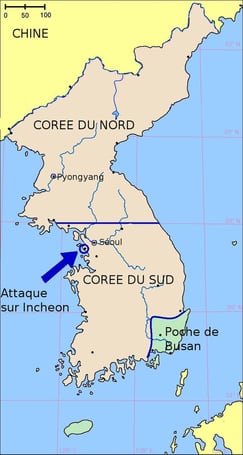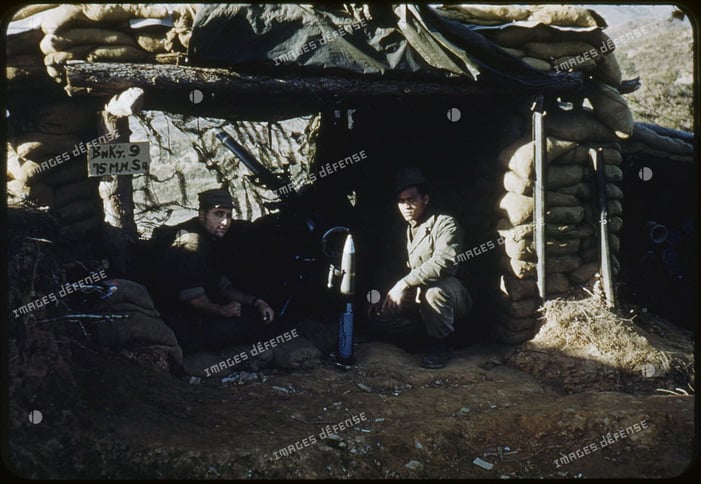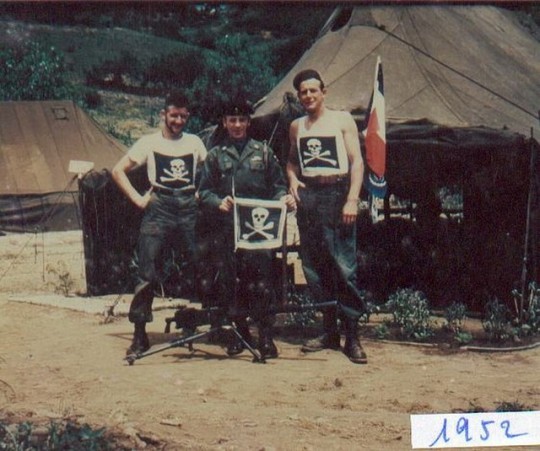A 75mm recoilless rifle of the French Battalion on the heighs of the T-Bone, summer 1952
© Gabriel Appay/ECPAD/Défense
under japanese control since 1910, Korea starts to be liberated in the last months of the second world war by the Red Army units coming through the northern border and from the chinese regions taken by the russians. On 6th and 9th of august 1945, hell fires fall from the skies onto Hiroshima and Nagasaki, forcing the rising sun empire to capitulate on the 15th of august, marking the end of a bloody and worldwide conflict.
Yesterday's allies are now turning against each other and the very next day after the armistice beggins a war which will only be cold in name, the cold war. The US understands quickly that the URSS is aiming at taking all of the quiet morning country and decides to land troops urgently on the 8th of september, agreeing to a split of the territory in two entities separated on the 38th parallel, with the russians controlling the norther part.
Border between South and North Korea in 1952. The parralel will stay the makeshift separation beteen the two states even with the two belligerents crossing multiple times each
The two republics created from this situation are already fomenting an invasion of it's neighbouring country to reunite the territory as a whole. The south, supported without great enthousiasm by the USA that fear the president's ambitions has a weak military, neither well trained nor well equiped. The North on the opposite can count on a much more tangible cooperation witht the communist states that provides tanks and attack planes as well as military advisors; Pyongyang is prepping for ferocious combats.
At the first lights on the 25th of june 1950, the northern units cross the parallel and steam-roll over the south's defences. In less than two months, the southern capital, Séoul, is captured and nearly all of the country has fallen. The civilians flea in apocalyptic conditions.
After the UN Security Council resolutions of 27th of june and 7th of july 1950, the creation of an "international police force" is decided under US command; it is the first time the newly created United Nations intervene to squash a conflict before it spreads further.
16 nations participate in the combat efforts, sending soldiers to confront the communist hordes underwhelming the southern troops.
entrenched on the Naktong river bed, korean and US militaries are clawing in to the Busan pocket, their back to the sea of Japan. Situation is desperate.
On the 15th of september, General Mac Arthur, hero of the Pacific campaign, goes for an assault landing on Incheon's port on the western side of the country to open a second front and attack behind the ennemy's lines.
Situation in september 1950, exhausted southern troops resist in Busan. A landing is undertaken to mitigate the pressure
Despite it's small size, Luxembourg sends soldiers. Note the camouflaged jacket on the second soldier which seems to me in the specific "moon and spheres" pattern indicating a potential belgian soldier
The French Battalion embarking upon the Athos II in the port of Marseille. They are still wearing french uniforms that will be swapped with US equipment upon arrival
© Ecpad, François de Castries
At the same time as the pinnacle of the first Indochina war that was keeping France busy, a far land caught on fire, warming up a just starting cold war. On the 25th of June 1950, communists troops of North Korea cross the 38th parallel and wreak havoc in th south, quickly taking the near complete territory of their neighbours.
The French Battalion in Korea
After the US landing in Incheon on the 15th of september, the northern troops break and quickly loose the terrain, being rebuffed back across the 38th parallel. It seems that the french that are still on the boat transporting them will arrive after the battle.
It was without counting on the Pyongyang's regime's supports and at the end of the year 1950, chinese swarm through the northern border, making the southern troops and the US military retreat. Again the situation is critical.
French Battalion's camp entrance in Kapyong
© Gabriel Appay/ECPAD/Défense
Upon their arrival on the theater, the french soldiers suffer from the reputation left after the 1940's debacle in american's minds, nobody's willing to trust them and the 2nd US Infantry Division from which they are a part of fear that they will flea at the first sound of gunshots; they are limited to small patrols and rear support.
But everything changes in january 1951; engaged at the battle of Wonju, the french prove themselves to be ferocious and sturdy; they earn the respect of their peers by holding their positions whatever the cost.
The city must be taken back from the chinese and after numerous fails to do so by the US military, the French Battalion which is getting short on ammo decides to change the cards and bayonnet charge the ennemy, stopping their offensive. The "frenchies" are now well respected and the american soldiers are happy to have them on their side during battle.
After a much needed restructuration to fill in the ranks left empty by the heavy casualties, especially officers and NCOs, the Battalion is sent back to the fights at the battle of Heartbreak Ridge in september and october 1951.
Near what is now the DMZ between the two Koreas, Heartbreak Ridge saw ruthless combat. The french have to climb the steep ravins going up to the chinese held ridge, in a rugged terrain and often at close quarter distance; only the US artillery and Air Force support vitrify the ennemy that looses over 10 000 of its men against 2000 casualties in UN ranks.
Creation of the French Battalion
A patrol under mortar fire in the Kumwha sector
© Gabriel Appay/ECPAD/Défense
A french commando attacking chinese nests at Heartbreak Ridge
© Gabriel Appay/ECPAD/Défense
Medical station against the slopes of Heartbreak Ridge
Picture from ECPAD
Coming from all military specialities, the soldiers forming the battalion are divided into three combat and one armoured companies where sappers, infantrymen, tankers, marines and lots of others rub shoulders together. Among them, some Indochina veterans, free french troops of WWII, trench hardened WWI Poilus and even a few that served in the French Volunteers Legion that fought bolshevism with the germans on the eastern front.
Leading them is an uncommon character that did not hesitate to swap his 4 General's stars with the 5 strips of a Lieutenant-Colonel to retain command of the freshly formed battalion; like most of his men, he's a volunteer.
Young Second Lieutenant in 1914, he joins the Besançon 60th Infantry Regiment. He will end the war wearing the 3 stripes of a Capitain, a Légion d'Honneur, 11 individual citations and 7 heavy injuries; he's declared 90% disabled.
In 1940 he takes the lead of the 13th Half Brigade of the Foreign Legion and is credited for the first allied victory of WWII under the snows of Narvik, Norway. Monclar joins the French Free Forces in England the day after De Gaulle's 18th of june call and fights in Northern Africa; however he refuses to fight Vichy's french soldiers on two occasions. He will see combat all along the Sahara and the Middle East.
Professionnal soldier and true warrior, he fights everywhere. General, he opposes the japanese and then the communists in Indochina, in Tonkin and Cochinchina. At nearly 60 years old, he volunteers to go to Korea but he's too high in the hierarchy; he decides to give back his stars to take back the rank of a Lieutenant-Colonel that he was appointed to 14 years prior to be able to command the battalion.
With more than 40 awards and medals, a Legion d'Honneur, 3 war crosses and numerous citations, the General Raoul Magrin-Vernerey -nicknamed Ralph Monclar- is one of the most decorated officers of the XXth century
image from legiondhonneur, all of his medals are on display in the Legion d'Honneur museum
To my knowledge, the only picture of the french forces at the battle of Wonju. You can see how harsh the conditions were
Picture Gérard Journet
A french temporary position at the top of Hill 1037 on the 5th of March 1951. In equally gruesome combat and weather, they still prevailed
Picture from paras
France, whom is a permanent member of the Security Council of the UN, is hesitating to send soldiers that are already needed in Indochina to Korea.
However, a battalion is put together in september in Auvours to support the UN troops already leading bloody fights on the ground.
A call for volunteers is shared in the papers to fill the ranks of this unit but some of the volunteers to fight in Indochina are diverted towards the war effort in Korea, joined later by some active duty soldiers.
A trench war ensues and lasts, along the 38th parallel. Soldiers come across bones and skulls whenever they try to dig a foxhole, combats rage to take a few meters of desolate terrain ravaged by shells and incendiaries; the ghost of 14-18 is back, nightmare from the past.
General Monclar, veteran from the first world war, will say to his men : "you will be able to tell your old mens that you lived something like Verdun".
Arrow-Head summit over the T-Bone valley
© Author unknown/ECPAD/Défense
A 75mm recoilless rifle in combat position on Arrow-Head
© Author unknown/ECPAD/Défense
They are finally relieved by a third contingent in december 1952 that will keep fighting at the cost of a great number of casualties until the ceasefire on the 27th of july 1953 and the agreement upon a DMZ separating the two Koreas until this very day.
3500 french soldiers fought over the mountains and hills of the quiet morning country, of them 288 lost their life and 1500 were injured. In total, they brought back over 2000 individual citations, a great number of medals, 4 citations to the french army's order, 3 US presidential citations and 2 korean presidential citations.
I am often participating to patriotic ceremonies and I've sadly never heard a single word spoken to the memory of those heroes that fought for the french military and died for its success.
May we never forget them.
To go a little further :
The movie "Heartbreak Ridge" from Jacques Dupont, released in 1955 from images filmed on the ground in 1952. During the original release in France, communists prevented people from entering theaters and smashed both the screening machines and the film rolls.
The ECPAD documentary "Korea, our forgotten soldiers" that is available here with english subtitles : youtube .
Communist troops entering a rubble reduced Séoul with the help of russian T-34s
KOREAN CENTRAL NEWS AGENCY/KOREA NEWS SERVICE VIA AP
Faux Lieutenant-Colonel and real 4 stars General Ralph Monclar on the left, one of the most decorated officer of the french military
Less than a month later, they distinguish themselves another time at TwinTunnels and Chipyong-Ni where they demonstrate a capicity to resist claw and teeth against the unnending maoists assaults even in dreadful winter weather. The Battalion will earn 2 citations to the french army's order and 2 US presidential citations for their bravoury.
Now recognized for their quality as warriors bu the high command, they are part of every firefight.
After a few days of earned rest and a visit from General Mac Arthur, the french are sent at the start of march to relieve a US battalion stationned under a rock tooth riddled with chinese bunkers, the "hill 1037". Even after many tries, the US are unable to take this heavily fortified position. Under atrocious conditions, the french attack the hill glazed by ice and snow where the ennemy just has to let the grenades roll along the descent to reach the assaulters. None of it matters for Monclar's men and they overwhelm the site in a few hours at the price of many fellow soldiers, fallen while taking machine gun nests.
Again, they show exemplary combatship during the battles of Putchaeteul and the Inje offensive, nicknamed "the may massacre".
On more than one occasion, the french avoided UN troops encirclement and took the most difficult ennemy positions. At the end of winter, the Battalion has lost half of it's soldiers and needs to be reinforced by active duty militaries coming from France.
French pioneers on Arrow-head
Picture from tumblr
The french will hold again on a last major battle succeding to the combats of the T-Bone area, the battle of Arrow-head in october 1952. Chinese assault was prepared by a merciless bombardment, in a few hours the french positions recieve more than 25 000 shells and rockets before being isolated from the rest of the UN troops by the flooding of the Yokkok river, courtesy of the chinese sappers. At nighfall, in numbers unseen to this day, the moists storm the forward outposts manned by the Battalion's pioneers; they will hold to the last man in hand to hand combat. Fights continues throughout the night with the chinese flooding the french devastated positions with thousand of infantrymen.
The sun rises at last, spelling the end of the people's liberation army that appears on the slopes in the clear daylight; every defender opens fire at once and slaughters the chinese troops that leave thousands of theirs along the mountains. Once again the french held.


































